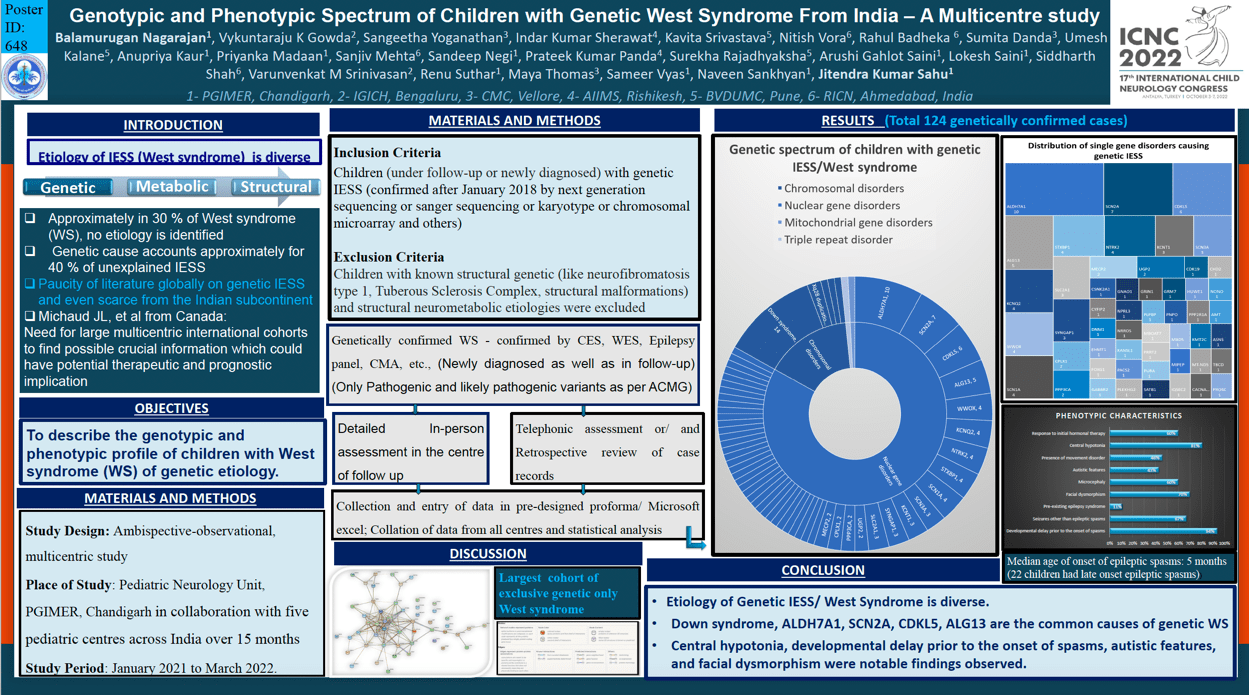Genotypic and Phenotypic Spectrum of Children with Genetic West Syndrome From Northern India
BALAMURUGAN NAGARAJAN, PRIYANKA MADAAN, ANUPRIYA KAUR, ARUSHI GAHLOT SAINI, RENU SUTHAR, LOKESH SAINI, SAMEER VYAS, NAVEEN SANKHYAN, JITENDRA KUMAR SAHU
OBJECTIVE To describe the genotypic and phenotypic profile of children with West syndrome (WS) of genetic etiology.
METHODS This ambispective observational study was conducted at a north Indian tertiary-care hospital over 15months (January 2021- March 2022). All children (under follow-up or newly diagnosed) with genetic WS (confirmed after first January 2018 on next generation sequencing or Sanger sequencing or Karyotype or Chromosomal microarray etc.,) were included. Variant classification was done as per American College of Medical Genetics and Genomics (ACMG) 2015 recommendations. Children with known structural genetic (like neurofibromatosis-1, Tuberous sclerosis, structural malformations) and structural neurometabolic etiologies were excluded. The clinical details and findings of laboratory, neuroimaging, and genetic investigations were recorded and analysed.
RESULTS Of 44 children with genetic WS, 4 had chromosomal disorder (trisomy 21), 38 had Mendelian monogenic disorders, 1 had mitochondrial gene disorder (pathogenic MT-ND5), and 1 had triple repeat disorder (fragile X syndrome). CDKL5, STXBP1, WWOX, and SCN2A were the common associated genes (Figure 1). Notable characteristics of the cohort include later onset of spasms (> 6-month-age)-6(13.6%), autistic features-25 (56.8%), facial dysmorphism-30(68.1%), microcephaly-16(36.3%), movement disorder- 20(45.4%) and central hypotonia-40(90.9%). All children with CDKL5, STXBP1 and SCN2A had autistic features. Around 60% children had an initial response to hormonal therapy.
CONCLUSION CDKL5, STXBP1, Down syndrome, WWOX, and SCN2A are common causes of genetic WS. Central hypotonia, onset of spasms before 6 months of age, autistic features, and facial dysmorphism were notable findings seen in more than 50% children with genetic WS.
Keywords: genetic , west syndrome, infantile spasms, epileptic spasms
BALAMURUGAN NAGARAJAN
PGIMER
India
PRIYANKA MADAAN
PGIMER
India
ANUPRIYA KAUR
PGIMER
India
ARUSHI GAHLOT SAINI
PGIMER
India
RENU SUTHAR
PGIMER
India
LOKESH SAINI
AIIMS JODHPUR
India
SAMEER VYAS
PGIMER
India
NAVEEN SANKHYAN
PGIMER
India
JITENDRA KUMAR SAHU
PGIMER
India
OBJECTIVE To describe the genotypic and phenotypic profile of children with West syndrome (WS) of genetic etiology.
METHODS This ambispective observational study was conducted at a north Indian tertiary-care hospital over 15months (January 2021- March 2022). All children (under follow-up or newly diagnosed) with genetic WS (confirmed after first January 2018 on next generation sequencing or Sanger sequencing or Karyotype or Chromosomal microarray etc.,) were included. Variant classification was done as per American College of Medical Genetics and Genomics (ACMG) 2015 recommendations. Children with known structural genetic (like neurofibromatosis-1, Tuberous sclerosis, structural malformations) and structural neurometabolic etiologies were excluded. The clinical details and findings of laboratory, neuroimaging, and genetic investigations were recorded and analysed.
RESULTS Of 44 children with genetic WS, 4 had chromosomal disorder (trisomy 21), 38 had Mendelian monogenic disorders, 1 had mitochondrial gene disorder (pathogenic MT-ND5), and 1 had triple repeat disorder (fragile X syndrome). CDKL5, STXBP1, WWOX, and SCN2A were the common associated genes (Figure 1). Notable characteristics of the cohort include later onset of spasms (> 6-month-age)-6(13.6%), autistic features-25 (56.8%), facial dysmorphism-30(68.1%), microcephaly-16(36.3%), movement disorder- 20(45.4%) and central hypotonia-40(90.9%). All children with CDKL5, STXBP1 and SCN2A had autistic features. Around 60% children had an initial response to hormonal therapy.
CONCLUSION CDKL5, STXBP1, Down syndrome, WWOX, and SCN2A are common causes of genetic WS. Central hypotonia, onset of spasms before 6 months of age, autistic features, and facial dysmorphism were notable findings seen in more than 50% children with genetic WS.
Keywords: genetic , west syndrome, infantile spasms, epileptic spasms
BALAMURUGAN NAGARAJAN
PGIMER
India
PRIYANKA MADAAN
PGIMER
India
ANUPRIYA KAUR
PGIMER
India
ARUSHI GAHLOT SAINI
PGIMER
India
RENU SUTHAR
PGIMER
India
LOKESH SAINI
AIIMS JODHPUR
India
SAMEER VYAS
PGIMER
India
NAVEEN SANKHYAN
PGIMER
India
JITENDRA KUMAR SAHU
PGIMER
India

BALAMURUGAN NAGARAJAN
PGIMER India
PGIMER India